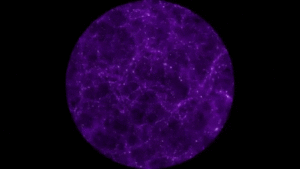After counting all the normal, luminous matter in the obvious places of the universe (galaxies, clusters of galaxies and the intergalactic medium) about half of it is still missing. So not only is 85% of the matter in the universe made up of an unknown, invisible substance dubbed dark matter, we can’t even find all the small amount of normal matter that should be there.
This is known as the “missing baryons” problem. Baryons are particles that emit or absorb light, like protons, neutrons or electrons, which make up the matter we see around us. The baryons unaccounted for are thought to be hidden in filamentary structures permeating the entire universe, also known as “the cosmic web”.
The universe is permeated by a vast, invisible web, its tendrils weaving through space. But despite organizing the matter we see in space, this dark web is invisible. That’s because it is made up of dark matter, which exerts a gravitational pull but emits no light.
That is, the web was invisible until now. For the first time, researchers have illuminated some of the darkest corners of the universe. Now a new study, published in arXiv, offers a better view that will enable us to help map what it looks like.
A long time ago, the universe was hotter, smaller and denser than it is now. There wasn’t much variation in density from place to place. space was much more cramped overall and no matter where you went, things were pretty much the same.
But there were tiny, random differences in density. Those nuggets had slightly more gravitational pull than their surrounding neighbourhood, so matter tended to flow into them and made them bigger.
In this way, they developed an even stronger gravitational influence which helped them pull more matter in and so on and so on for billions of years. Simultaneously, as the nuggets grew, the spaces between them emptied out. Eventually, the dense patches grew to become the first stars, galaxies and clusters, while the spaces between them became the great cosmic voids.
The vast majority of matter in our universe is dark; it does not interact with light or with any of the normal matter. As a result, much of the cosmic web is completely invisible to us.
Now we can easily spot the great cosmic voids because there are no galaxies to illuminate these spaces as we know there is no matter there. It’s just truly empty space. But the grandeur of the cosmic web lies in the delicate lines of the filaments themselves. Stretching for millions of light-years, these thin tendrils of galaxies act like great cosmic freeways crossing black voids, connecting bright urban clusters.
Those filaments in the cosmic web are the hardest part of the web to study. They have some galaxies but not a lot. And they have all sorts of lengths and orientations; in comparison, the clusters and voids are geometric child’s play. So, even though we’ve known of the existence of filaments, through computer simulations, for decades, we have had a hard time actually, you know, seeing them.
Recently, a team of astronomers made a major advancement in mapping our cosmic web, publishing their results at the arXiv database. First, they took a catalogue of luminous red galaxies (LRGs) from the Baryon Oscillation Spectroscopic Survey (BOSS) survey. LRGs are massive beasts of galaxies, and they tend to sit in the centres of dense blobs of dark matter. And if the LRGs sit in the densest regions, then lines connecting them should be made of the more delicate filaments.
But staring at the space between two LRGs isn’t going to be productive; there isn’t a lot of stuff there. So, the team took thousands of pairs of LRGs, realigned them and stacked them on top of each other to make a composite image.
Using this stacked image, the scientists counted all the galaxies that they could see, adding up their total light contribution. This allowed researchers to measure how much normal matter made up the filaments between the LRGs. Next, the researchers looked at the galaxies behind the filaments, and specifically, at their shapes.
As light from those background galaxies pierced the intervening filaments, the gravity from the dark matter in those filaments gently nudged the light, ever so slightly shifting the images of those galaxies. By measuring the shear (the amount of shifting), the team was able to estimate the amount of dark matter in the filaments.
That measure lined up with theoretical predictions (another point for the existence of dark matter). The scientists also confirmed that the filaments weren’t entirely dark. For every 351 suns’ worth of mass in the filaments, there was 1 suns’ worth of light output.
It’s a crude map of the filaments, but it’s the first, and it definitely shows that while our cosmic web is mostly dark, it’s not completely black. This will help reveal more mystery surrounding the cosmic web and provide us with a definitive census of the matter in the universe.

